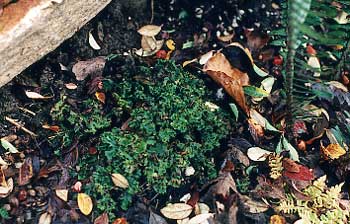 Liverwort
Liverwort
I spotted a glob of green stuff growing in a discarded nursery pot full of loam. "What is this, a green brain?" I asked, & was told, "It's moss."
It was so leathery & sponge-like, I doubted it was moss. Still, being permitted to take the glob home for free, I divided it, planting it in a couple of spots under sword ferns near a stone wall. A year or so later it had become two six- or eight-inch round patches.
I eventually figured out it is liverwort ( Marchantia polymorpha), a variety that frequently invades greenhouses unbidden & ends up in plants commercially grown in pots.
Some people regard it as a weed which, if conditions are too ideal for it, can by some testimonies spread aggressively & seal off the soil from other plants' use. But I enjoyed it as a weird little groundcover & never for a moment regretted encouraging it.
I rather suspected it would quickly vanish if I didn't keep the leaf-litter off of it, as it has not been the least competitive. And indeed, as the area around the ferns became more & more overgrown, & I less swift to clean fallen leaf matter off of it, it did vanish after three years.
Liverwort does have champions, including herbalists who value it for purported medicinal uses. "Wort" means "Herb," & it is called the Herb of the Liver because of an old belief that it could cure liver disease & hydrophobia (rabies). There's no substance to the belief, which was based on no actual medicinal property, but only on liverwort having the physical texture of animal livers (see my article on the Doctrine of Signatures, the first widely popularized "alternative medicine" which set the tone of quackpottery for all time).
It does have tannic acid with mild astringent properties. And depending on the soil it grows on, it may well be rich in minerals, including heavy metals with the attendant toxic risks. M. polymorpha has been pharmaceutically relevant in gene-splicing & cloning research, though any direct medicinal value appears at best trivial.
The primitiveness of liverworts fascinates botanists. Wildlife illustrator Richard Bell wrote of M. polymorpha, in keeping with my sentiments: "At the nurseries I notice what a botany enthusiast once referred to as 'garden centre liverwort.' She thinks it's worth buying a potted plant just to have an example of this exotic looking life form!" The Missouri Botanical Garden's Bryophyte Herbarium specializes in growing many varieties of liverwort, & the Royal Botonic Garden in Edinburgh has numerous species in their fern house, rock house, & peat house.
Many of the liverworts are too fragile to grow in the garden, requiring specially lit high-humidity terrariums. The "greenhouse liverwort" is a notable exception, being distributed world-wide from tropic to arctic regions & highly adaptable, though rarely if ever a dominant species in any ecosystem.
Most liverworts prefer shade, but greenhouse liverwort loves warm moist soil in full sunlight. Before I knew what it was, I assumed it would only live in deep shade & situated it accordingly; perhaps its weedy potential would have been more evident if I'd put it in a sunnier spot, but I was happy it thrived so controllably amidst well-shaded ferns for as long as it did. The patches I had might have been restrained, too, because liverwort prefers limey soil, but acid soil basic to the Northwest.
After forest fires, this liverwort is the first thing to reappear, carpeting moist ground near riverbeds & springs & swamps, happy in the muddy alkaline ashes, fully exposed to the sky. It is responsible for stopping erosion in such post-fire conditions, & assists in purifying contaminated water.
Despite some garderners' worries about it retarding seedlings by sealing over the ground, in the burned areas that it soon carpets, it is not long before it is displaced by true mosses & larger herbs, then further displaced by shrubs, becoming scarcer & scarcer as the forest restores itself. So really it does only good work in the wild, harming nothing.
Though I'd placed it in a shady "forest garden" area where it was bound to exhibit slow growth & eventually be displaced altogether, in a damp sunny alkaline area it would've spread swiftly. One under-utilized value for landscaping is how it will become an attractive groundcover in damaged areas that will sustain almost no plantlife. This would include a slimy-mud area such as sometimes develop near sidewalks that have leeched too much alkalinity from concrete along a run-off; or on gouged skid-trails that begin to gully after rainfall, having lost all topsoil; or in wet areas that have become contaminated with heavy metals. Such an area can be transformed from slimy ditch to bright green carpet of liverwort.